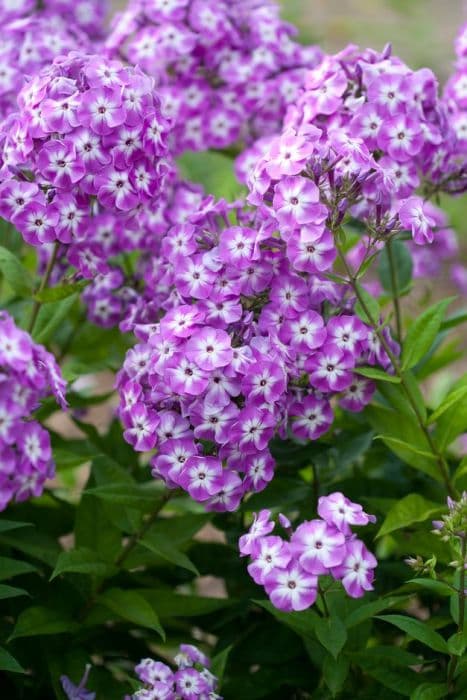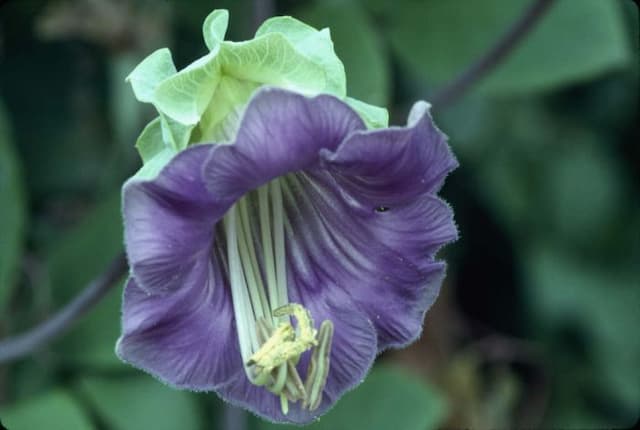Perennial phlox 'Little Boy' Phlox paniculata 'Little Boy'

ABOUT
'Little Boy' is a herbaceous perennial 40-80cm high with green lance-shaped leaves and clusters of fragrant lilac-pink flowers with white centres from summer to autumn
About this plant
 Names
NamesFamily
Polemoniaceae
Synonyms
Garden Phlox, Summer Phlox, Perennial Phlox, Tall Phlox
Common names
Phlox paniculata 'Little Boy'
 Characteristics
CharacteristicsLife cycle
Perennials
Foliage type
Deciduous
Color of leaves
Green
Flower color
Pink
Height
2-3 feet (60-90 cm)
Spread
1-2 feet (30-60 cm)
Plant type
Herb
Hardiness zones
4
Native area
Eastern United States
Benefits
 General Benefits
General Benefits- Attracts Pollinators: Phlox paniculata 'Little Boy' is known to attract butterflies and bees, promoting biodiversity in the garden.
- Long Blooming: Garden Phlox has a long blooming period, providing continuous color from early to late summer.
- Easy to Grow: This variety of Phlox is relatively easy for gardeners to grow, requiring minimal maintenance once established.
- Fragrant Flowers: The blooms emit a pleasant fragrance that can enhance the sensory appeal of any outdoor space.
- Cut Flowers: The long stems and colorful blossoms make Phlox paniculata 'Little Boy' ideal for use in floral arrangements.
- Drought Tolerant: Once established, this plant has good drought tolerance, reducing the need for frequent watering.
- Deer Resistant: Phlox is generally resistant to deer, making it a suitable choice for gardens in areas with high deer populations.
- Visual Appeal: With its vibrant colors and structured form, Phlox adds aesthetic value to garden beds, borders, and landscapes.
- Compact Size: 'Little Boy' is a more compact cultivar, making it suitable for smaller gardens or spaces with limited room.
- Versatile Planting: Suitable for mass plantings, perennial borders, and as an accent plant, offering a variety of landscaping uses.
 Medical Properties
Medical Properties- This plant is not used for medical purposes.
 Air-purifying Qualities
Air-purifying QualitiesThis plant is not specifically known for air purifying qualities.
 Other Uses
Other Uses- As a natural fabric dye: The flowers of Phlox paniculata 'Little Boy' can be used to create a range of purple and pink dyes for fabrics, offering an eco-friendly alternative to synthetic dyes.
- Culinary garnish: The edible flowers can add color and a light, spicy flavor to salads and desserts, enhancing the presentation and taste of various dishes.
- Education and research: This plant can serve as a subject in botanical studies or horticulture classes, teaching about pollination, plant breeding, or growth patterns.
- Photography and art: The striking colors and form of Phlox paniculata 'Little Boy' make it an excellent subject for botanical photography and floral art compositions.
- Garden design and landscaping: The plant can be used in thematic gardens, such as Victorian or cottage gardens, due to its traditional aesthetic appeal.
- As a natural pest deterrent: Some gardeners plant Phlox paniculata 'Little Boy' among vegetables and fruits to help ward off certain pests, although its effectiveness may vary.
- Ingredient in potpourri: Dried flowers of Phlox paniculata 'Little Boy' can be included in homemade potpourri mixes for a natural, subtle fragrance in the home.
- Crafts and decoration: The flowers can be incorporated into wreaths, centerpieces, or other floral crafts for events and home decor.
- Marking seasons in a garden: The blooming period of Phlox paniculata 'Little Boy' can serve as a natural indicator of the late summer season in temperate gardens.
- Candle making: Petals of Phlox paniculata 'Little Boy' can be embedded into homemade candles for decorative effect.
Interesting Facts
 Feng Shui
Feng ShuiGarden Phlox is not used in Feng Shui practice.
 Zodiac Sign Compitability
Zodiac Sign CompitabilityGarden Phlox is not used in astrology practice.
 Plant Symbolism
Plant Symbolism- Harmony - Phlox symbolizes harmonious partnership and unity, which can be reflected in the 'Little Boy' variety with its cohesive growth and the way its flowers blossom in unison.
- Agreement - The blooming of Phlox signifies the reaching of an agreement or accord, as its flowers seem to live in agreement with each other on a single stem.
- Proposal - In the language of flowers, offering a bouquet of Phlox can represent a marriage proposal, as it stands for the union of two hearts.
- Sweet Dreams - The 'Little Boy' cultivar, like other Phlox varieties, can be associated with wishing someone sweet dreams, reflecting its gentle appearance and calming presence in a garden.
 Water
WaterGarden Phlox should be watered regularly, especially during dry spells, to keep the soil evenly moist but not soggy. A good rule of thumb is to water them with about an inch of water per week, but this can vary depending on climate conditions. It's best to water at the base of the plant to avoid wetting the foliage, which can lead to fungal diseases. During hot summer periods, watering may need to be increased. Overhead watering should be avoided to prevent mildew development on the leaves.
 Light
LightGarden Phlox thrives best in full sun to partial shade. Ideally, the plant should receive at least six hours of direct sunlight a day, which will help promote strong, healthy growth and abundant flowering. It can tolerate some afternoon shade, especially in regions with very hot summers.
 Temperature
TemperatureGarden Phlox is hardy and can usually withstand temperatures as low as -20 to -30 degrees Fahrenheit during dormancy in winter. The ideal growing temperatures for Garden Phlox range between 60 and 70 degrees Fahrenheit. They can tolerate summer heat but might require additional watering during particularly hot spells.
 Pruning
PruningGarden Phlox should be pruned to encourage bushier growth and more blooms. Deadhead spent flower heads regularly to promote continuous flowering throughout the season. After the growing season, in late fall or early spring, cut back the stems to about 1 or 2 inches above the ground. This helps to maintain a tidy appearance and prevents potential disease from overwintering in dead foliage.
 Cleaning
CleaningAs needed
 Soil
SoilGarden Phlox, commonly known as Phlox paniculata 'Little Boy', thrives best in a soil mix that is rich in organic matter with good drainage. A mixture of garden soil, compost, and perlite or coarse sand can create the ideal growing condition. For optimal growth, maintain the soil pH between 6.0 and 7.0. Regularly incorporating organic matter like compost or well-rotted manure will also boost soil fertility and structure.
 Repotting
RepottingGarden Phlox should only be repotted or divided when it's necessary, typically every 3 to 5 years. If the perennial clump becomes too crowded or shows signs of reduced vigor, it's time to divide it in the spring or early fall. Replant the divisions at the same depth they were originally growing to ensure the continued health of the plants.
 Humidity & Misting
Humidity & MistingGarden Phlox does not require high humidity and can tolerate the typical outdoor humidity levels found within its hardiness zones. It is adaptable to average garden conditions but should not be kept in overly dry environments for extended periods as it can lead to stress on the plant.
 Suitable locations
Suitable locationsIndoor
Provide bright light, well-draining soil, and water when dry.
Outdoor
Plant in rich soil, full sun to part shade, and water regularly.
Hardiness zone
4-8 USDA
 Life cycle
Life cyclePhlox paniculata 'Little Boy', commonly known as Garden Phlox, begins its life as a seed, typically requiring cold stratification to germinate. Upon sprouting, the seedling develops into a young plant with a few sets of true leaves, establishing a small root system. As it matures, the plant forms a clump with upright stems, lush foliage, and multiple growing points. During the growing season, it produces clusters of fragrant, colorful flowers on top of the stems, attracting pollinators such as butterflies and hummingbirds. After flowering, if not deadheaded, the plant sets seed, which can fall to the ground and potentially sprout new plants the following spring. In the autumn, after the first hard frost, the plant's above-ground parts die back, and it overwinters as a root system with potential to regrow when the conditions become favorable again in the spring.
 Propogation
PropogationPropogation time
Spring to summer
Phlox paniculata 'Little Boy', commonly known as Garden Phlox, is often propagated during spring or early summer when the plant's growth is most active. The most popular method is through stem cuttings. To do this, select a healthy stem that is 4 to 6 inches long with several leaf nodes. Snip the stem just below a node using a clean, sharp pair of gardening shears. Remove the leaves from the lower half of the cutting to prevent decay when planted. Dip the cut end in rooting hormone to encourage root growth, then plant the stem in a mixture of half potting soil and half perlite or sand to ensure good drainage. The cutting should be kept in a warm, humid environment with indirect sunlight until it roots, which generally takes about 3 to 4 weeks.









